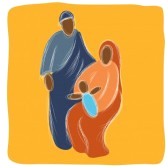To Listen to this Sermon, Click Here -> http://ststphnfw.sermon.tv/9824805
Luke 2: 1-20
Christmas Eve, 2013
Mary, the mother of Jesus, was a young girl betrothed to Joseph when she found herself to be pregnant. For some reason—apparently a heavenly one—Joseph chose to marry her despite this apparent pre-marital slip-up. Jesus was her first child. It appears that she bore at least three more boys, and possibly a daughter. She helped raise one older boy, James, who was likely Joseph’s son from a previous marriage. Three other sons are identified: Joseph, Judas, and Simon (Matthew 13: 55). Certainly James was a disciple of Jesus—though not one of the Twelve apostles–and possibly Simon and Judas as well.
Scripture suggests that there was tension between Jesus and his family, tension that may have caught Mary in the middle between her perplexing, gifted firstborn and her other children. Nonetheless, even into adulthood, Jesus’ relationship with his mother was crucial. She was herself one of his disciples. In the Gospel of John, Mary, the mother of Jesus, was standing near the cross, along with two other women. At the crucifixion, many of Jesus’ followers abandoned him. According to John, though, Mary, Jesus’ mother, stayed at the foot of the cross until her firstborn son died.
This is the powerful, poignant moment that Michelangelo captures so well in his sculpture, The Pieta. In it we see Mary, impossibly young, as young as the virgin mother who first bore the infant Jesus, doing the impossibly strong thing of bearing the body of the crucified, full-grown Jesus in her arms. The life of mother and son come a full circle: the mother who bore him into life, bears him in death as well.
Luke tells us when Joseph and Mary took infant Jesus to be circumcised, they met an old prophet named Simeon who told Mary that God had a great destiny for this child—but that “a sword will pierce [her]own soul, too” (Luke 2:35).
In the gospel Luke, Mary represents the anawim—the poor of God. It is a tradition as old as the earliest writings of the Bible, always represented by women who struggle with their identity in a world dominated by men, in which their only power is their ability to attract men or to bear children.
The anawim, the Poor of God, cry out to God for justice for themselves—for justice for their children and families—for justice for their people—for justice in the world. Their great virtue is their awareness that they have no power, and so they have no choice but to depend absolutely, and beyond all else, on God.
In our Gospel reading, it is the poor who are given hope. It is the poor who are assured that their wait is over. Shepherds, the poor of God, are told tidings of great joy that shall be to all the people. Mary, a teenaged girl caught in the terrible situation of an unexpected pregnancy, is honored to be the Mother of the Savior of the World, the Son of God. When she is visited by the angel Gabriel earlier in Luke, she hears this shocking news and says, “Let it be to me as you have said.” Her humility, her willing submission to the demanding, but hopeful will of God, is what makes her the greatest representative of the anawim.
As does the later, terrible, piercing of her heart that the Pieta so powerfully depicts—a mother grieving the untimely loss of a child in whom was placed so much hope.
Mary is the representative of the poor everywhere, and the representative of Jesus’ own interest in the poor—of the Gospel’s profound care and concern for the poor. In more recent weeks, the Roman Catholic Pope Francis I has been our modern representative of the anawim, the poor of God. In his controversial document Evangelii Gaudium, the pope, representative of the church that has tried hardest to honor Mary, challenges Roman Catholics, Christians, and the world, to recognize that we have an obligation to the poor.
“The goal of economics and politics is to serve humanity, beginning with the poorest and most vulnerable wherever they may be, even in their mothers’ wombs,” he writes. “Every economic and political theory or action must set about providing each inhabitant of the planet with the minimum wherewithal to live in dignity and freedom, with the possibility of supporting a family, educating children, praising God and developing one’s own human potential.”
He continues: “We have created new idols. The worship of the golden calf of old has found a new and heartless image in the cult of money and the dictatorship of an economy which is faceless and lacking any truly humane goal.”
There are so many poor in the world who live their own Pieta—bearing in their arms the dead body of the hope they long ago conceived. A sword piercing their heart. Some of us think that we can create a new hope with Golden calves of our own devising—but they only make a mockery of our true spiritual poverty, and of the true hope God offers us. Pope Francis reminds us that hope is never dead—it is God’s will for us, and God’s will for the world. It is meaning of Christ’s life, death, and resurrection. It is truest purpose to which we are called–to have hope and to offer hope to others.
It’s worth bearing in mind one final thing that Luke tells us about Mary: Three days after Mary watched her son die on that cross, she was one of the three women who visited Jesus’ tomb and found it empty. An angel told them: “He is not here—he is risen.” The sword piercing her heart was replaced—replaced by hope. Hope in the Gospel. Hope for her. Hope for the poor. Hope for the world.
Hope for us all.

